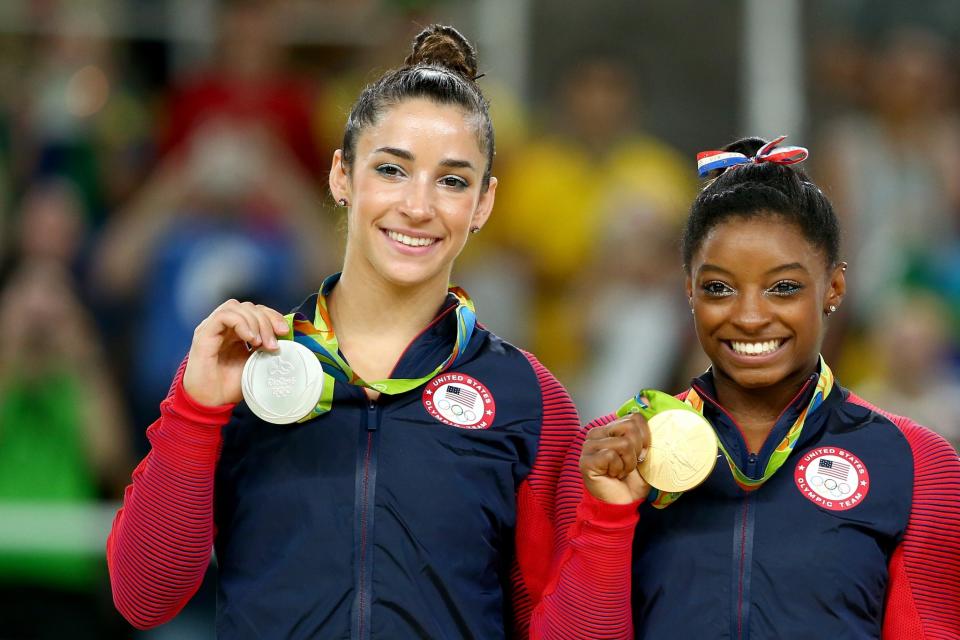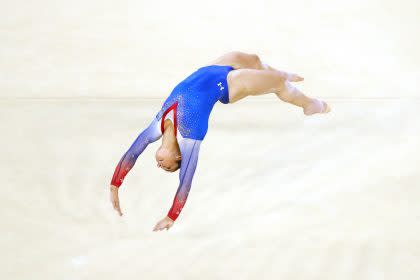What the future holds for Simone Biles, Aly Raisman and the sport of gymnastics
Medal count | Olympic schedule | Olympic news
RIO DE JANEIRO — They are teammates and suitemates and, they both agree, friends, if not sisters of some sort. About the only thing Simone Biles and Aly Raisman argue about is Raisman’s preferred bedtime, which resembles something out of a senior living facility. Nine sharp. If that late.
The other night, Biles, 19, was making some noise while Raisman, 22, was trying to doze off. Raisman complained.
“It’s 9:45,” Raisman recalled. “I don’t think it’s that crazy to ask you to be quiet.”
“[I said] ‘Aly, that’s 12 hours to sleep, you’ll be fine,’ ” Biles said of a free schedule in the morning. “It’s not hibernating time.”
“The last year and a half I haven’t hung out with my friends,” Raisman said. “The other 21-, 22-year-olds just want to go out and party all night. I’m too tired. I’d rather get a good night sleep.”
“We always tell Aly, ‘You can sleep when you’re dead,’ ” Biles said.
Both Biles and Raisman laughed at the story, laughed at the experience of these Games, laughed the laugh you can when they keep hanging medals around your neck. On Tuesday, the two Americans closed the Olympic gymnastics meet going gold (Biles) and silver (Raisman) in the floor exercise final to conclude a week-and-a-half of domination from the two of them.
It might as well have been two golds. Biles won four of them here. Raisman got one and two silvers, although she admits that when she had to match up against Biles, she was just gunning for silver anyway.
“I don’t even consider myself competing against [Simone],” Raisman said. “She is just at another level. I think Laurie [Hernandez] said, ‘If you get silver again, you’re the best because Simone doesn’t count.’ ”
The afternoon capped an audacious, outrageous, record-tying medal haul (nine total) for the United States. And it capped it in the most positive of possible ways, not just for these two but also for the trajectory the sport of gymnastics appears to be experiencing.
This was another display of power and athletic ability and practice and perfection and pushing the boundaries of what is humanly possible. There was a time when this sport tended to favor artistry and elegance, and while Biles and Raisman certainly possess both, they ruled this meet through blunt force athleticism. There were a lot of spectacular passes, soaring flips and incredible challenges.

This is a tremendous development for any number of reasons. If nothing else, it bodes well for both of them possibly returning to elite competition, including gunning for Tokyo in 2020.
Biles would be 23. Raisman would be 26. Over the previous eight Olympics, the average age of all-around champions was 17.1. None were older than 20.
That was then. This, hopefully, is the future.
“I just say I get better with age,” Raisman said. “So maybe I will.”
There was a time when 26 wasn’t the better age.

“There is no reason in the world to get out,” said Mihai Brestyan, Raisman’s coach. “Twenty-six is doable. Look around … I don’t see what can stop them. … She’s strong. She’s healthy. She is in her best shape, ever.”
When lithe and limber were too often rewarded by judges, gymnasts were done competing before their teen years were complete. Naturally growing a couple of inches or gaining even a few pounds was career-ending. Once, they all had to perform the same routine, making fluidity an overvalued commodity to judges. It pushed the sport younger and younger.
As recently as the 2008 Olympics, U.S. team coordinator Marta Karolyi accused the Chinese of cheating by bringing in gymnasts who were below the then-16-year-old age minimum. She claimed Chinese gymnasts, which included a 4-foot-6, 68-pound girl and another 4-7, 70-pounder, were as young as 12 and “still had their baby teeth.” When weighing 60-something pounds is deemed an unfair advantage, a sport has issues.
“They are using half-people,” Karolyi said then. “What arrogance.”
Kids that small, and thus likely lacking in leg strength, wouldn’t have stood a chance here in Rio. It was a 21-year-old Russian, Aliya Mustafina, competing in her second Olympics, that joined Biles and Raisman on the all-around podium.
Under current scoring standards, gymnasts can increase their difficulty scores, and if they deliver, they deliver because judges are rewarding it. There still is the manner in which it is done, with make-up worn and sequins sewed, and it isn’t perfect. But it is a vast improvement that hopefully will continue. It would allow actually grown women to keep competing.
This also is good for gymnastics at all levels, an activity with a difficult history of young girls dealing with weight concerns that led to eating disorders and unhealthy behavior. The more it becomes about being a natural, healthy athlete, the better. The more it is about what you can do than how you look doing it, that’s even better.
[Photos: The Makings of Greatness – Aly Raisman at London 2012 Olympics]
Karolyi has seen it come a long way from the 1970s, when she and her husband Bela coached in Romania and every gymnast had to do the exact same compulsory routine.
“In ’76, the judging system was completely different. It was a 10.0,” Karolyi said of the Montreal Games in which their star performer, Nadia Comaneci, delivered the first perfect 10. “There was not specific values given to specific skills.”
“Nowadays the scoring system is based on counting the difficulty,” Karolyi continued. “The higher difficulty, the more points you are able to collect. And then you have an execution score which awards how perfectly the skills are done.”
Essentially, a better athlete can raise the possibility above 10, changing the game. That’s what Biles in particularly did here with extreme difficulty combined with tremendous execution.
“I would never describe [Simone] as being elegant, but her tumbling even has good form,” said Aimee Boorman, Biles’ coach. “Now this crop of girls, they are throwing in the big skills and making it look beautiful.”
So now, if they choose, Biles, Raisman and others have a better chance of trying to push the envelope in the future. Raisman, for instance, said her breathtaking first tumbling pass on floor took six years to conceptualize and then perfect. That used to be an entire career. In this case, it elevated her to be even better at 22, when she had built up the strength to deliver it, than at 18.
And at 26? Or 23 with Biles? There is no telling.
Neither wanted to commit to anything for certain, other than they were going to have a pizza party Tuesday night, indulging on some long-coveted carbs. Both planned on cashing in on their fame and earning money to keep the future possible.
Biles will be a sophomore at UCLA this year. Raisman might even stay up past nine.
The future is up to them, but that’s the point. A sport that for so long deemed its greatest champions too old by 17 or 18 suddenly has changed. At least for now. At least a little, which hopefully becomes a lot.
“It’s pretty insane what I accomplished in my first Olympics …” Biles said.
Her first. Just imagine where the sport heads if it’s not her last?
More Summer Olympics coverage on Yahoo Sports:

